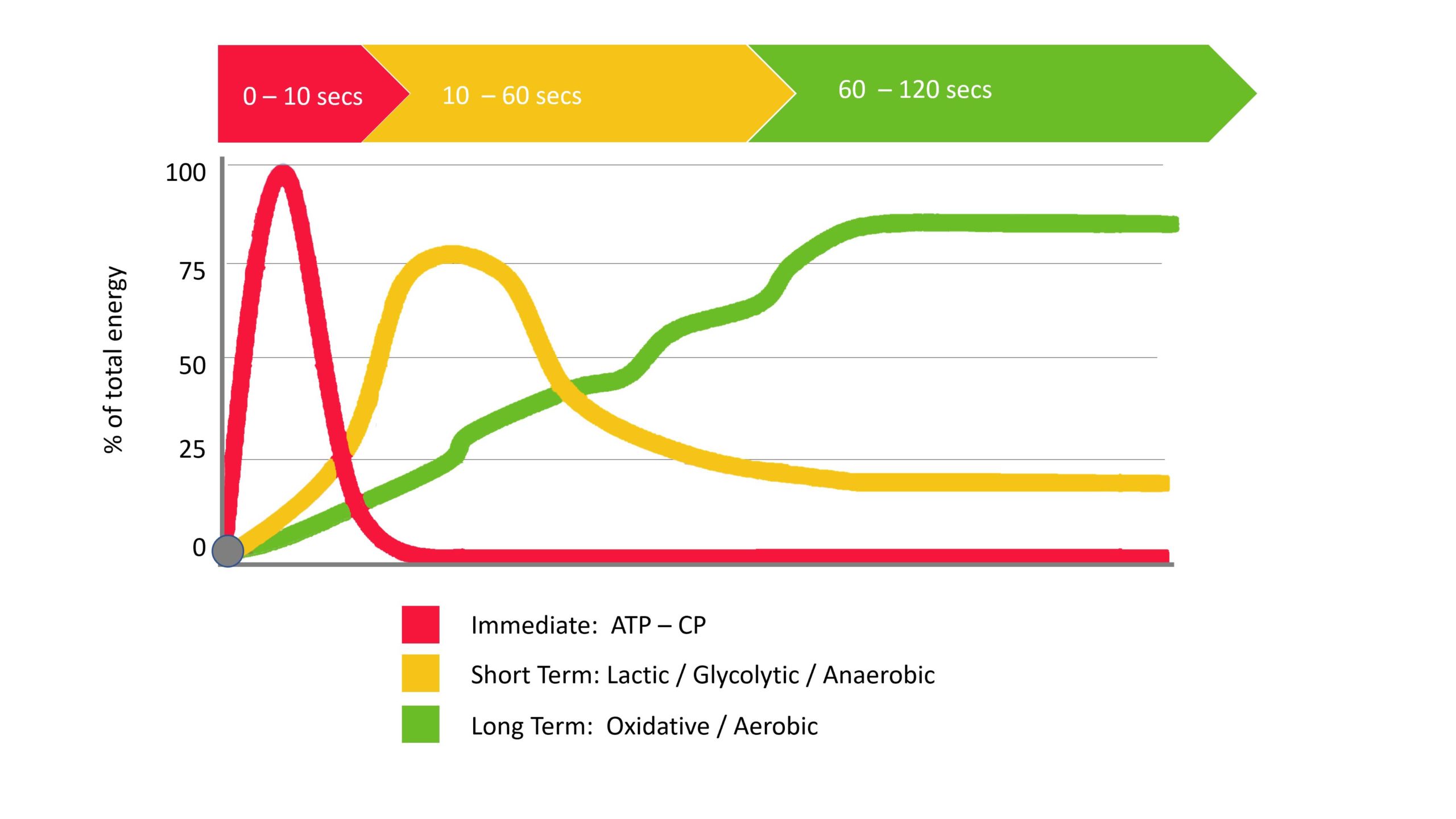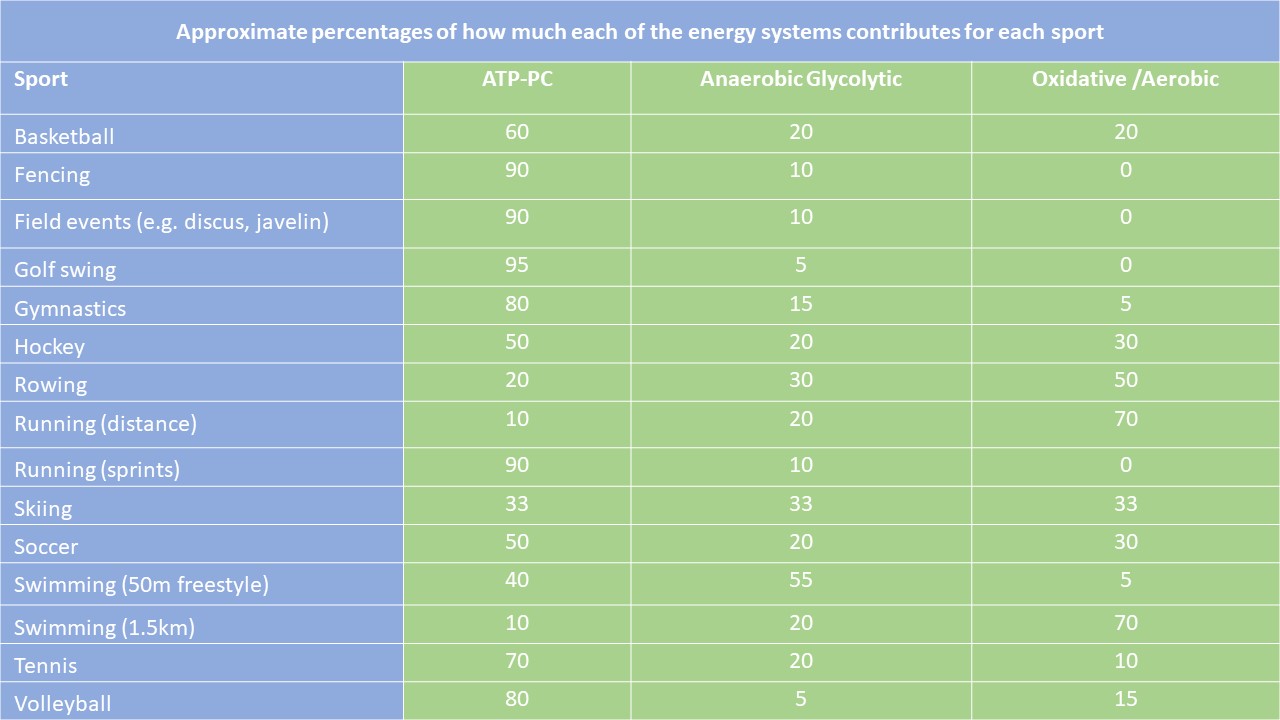How the body uses energy

The first law of thermodynamics is known as the ‘Law of Conservation of Energy’ and it states that energy cannot be created or destroyed in an isolated system.
In a similar way that cars need fuel to move, the human body needs to convert nutrition into energy so we can move and function. Knowing the basics of how we generate energy can be helpful in understanding how we become fatigued and what training we can undertake to minimize fatigue. Just as you train your biceps or your hamstrings, you can train your energy systems for better conditioning and performance.
Energy systems and how they work may sound like something you don’t need to take seriously unless you are an elite athlete. But how our bodies convert our fuel (nutrition) into motion is relevant to everyone. We all use the 3 different energy systems all the time and the performance of your energy system affects your health and well-being.
In order to care for your energy system, you need to engage in regular exercise and keep these systems working efficiently. This blog aims to give a high level and somewhat simplistic overview of the body’s energy system, but you can delve into more detail by checking out the references detailed at the end.
How does the body produce energy during exercise?
Let’s start with how the body produces energy. Any exercise requires a constant supply of energy. This energy is supplied to all cells by an organic compound called Adenosine Triphosphate (ATP) which is generated from mostly fats and carbohydrates but in some cases proteins – so essentially, it’s an end product of your nutritional intake. ATP is often referred to as the ‘energy currency of life’. It is vital for life and if we did not have it, we would not be able to survive. ATP is the only direct source of energy that your muscles can use. Without it, your muscles can’t contract, and you won’t be able to exercise. Individual muscle cells contain small quantities of ATP ready for immediate use, but these will only fuel a few seconds so additional ATP needs to be retrieved from other source(s).
The three energy systems used to produce ATP are:-
Immediate: Anaerobic ATP-PC/Phosphagen
This consists of ATP that is already stored in muscle and Phosphate Creatine (PC). This energy system can rapidly replenish ATP and is an anaerobic system requiring no oxygen for energy production. In total all of your body’s phosphagen stores (ATP + PC) can fuel exercise for about 10 seconds before being depleted. This is the fastest source of energy and is suitable for short sharp intensive bouts of exercise. Examples of exercise that will primarily use this system would be sprinting as fast as you can for 50 – 100 meters. This energy depletes quickly, and you need to rest for 2 minutes or more to replenish it.
Short Term: Lactic Acid/Glycolytic/Anaerobic
Because ATP is stored in limited quantities within each muscle cell, each muscle fiber must be able to create its own supply from fuels derived from nutritional intake. This short term system supplies the additional energy for activities that last longer than 10 seconds and up to about 2 minutes. The lactic acid system also produces energy without using oxygen. It does this by breaking down muscle glycogen with is a form of stored glucose in the muscle. On release, glycogen produces energy through a process called glycolysis, which forms lactic acid as a by-product. Lactic acid can build up in the muscles and they can be felt to ‘burn’ when undergoing intensive activity. However while lactic acid production often accompanies fatigue and muscle soreness, it doesn’t directly cause it. Recent research has focused less on the supposed detrimental effects of lactic acid and more on the ability of the body to metabolize lactic acid as a source of replenishing ATP supplies. The breakdown of lactic acid results in rising levels of hydrogen ions which cause increased acidity in your tissues which contributes to fatigue. As lactic acid is rapidly cleared from your muscles, it is also not the cause of Delayed Onset Muscle Soreness (DOMS) as previously thought. This is thought to be as a result of microscopic tearing of muscle fibers due to movements you are not used to.
Long term: Oxidative / Aerobic
The oxidative or aerobic energy system can produce far more ATP than either of the other energy systems but it does so much more slowly, therefore it cannot fuel intense bouts of exercise that demand faster production of ATP. The aerobic energy system is used for prolonged endurance or exercise. Simply put the cell uses oxygen to burn glucose and make ATP i.e. aerobic production of energy by the oxygen system. Your muscles need a steady supply of ATP during any sustained activity. This is lower power, but you have a virtually endless supply available depending on your aerobic fitness levels. This is also how ATP is formed during rest conditions. When breathing and heart rates are at resting levels, there is an abundance of oxygen supply and 2/3rds of the ATP is generated from fat stores in the body. The other 1/3 is from carbohydrates.

How do the energy systems work together?
In the past it was believed that ATP was produced by the different energy systems in a sequential manner but it is now known that energy is derived from each of the energy producing systems during almost all exercise activities. Research studies have concluded that the aerobic system plays a significant role in determining performance during high intensity exercise. The aerobic system can respond quickly to the demands of intense exercise even though it is incapable of meeting the energy demands at the beginning of the exercise due to its slower production of ATP.
How can our energy systems be trained to be more effective and efficient?
As part of building up fitness levels and striving for peak performance an athlete needs to be able to cope with higher workloads and balance training intensity and recovery. An effective training program should maximize use and development of each energy system. If the aerobic capacity is greater, more oxygen is available to the working muscles and this helps delay the onset of lactic acid when a certain intensity is reached. The topic of ‘metabolic efficiency’ is growing in popularity. Being metabolically efficient means that you are able to use the proper nutrients that are stored in the body at the right times to maximize performance. The specific energy demands of an athlete vary between different sports. Determining the duration of activity, the intensity of activity and the time elapsed between different bouts of intense activity is necessary in order to come up with suitable training plans that aim to provide suitable energy system training for that sport and indeed individual positions within that sport. Edward Fox in his book ‘The Physiological Basis for Exercise and Sport’ provides an approximation of the percentage contribution of each of the energy systems for certain sports illustrated below.

Understanding how energy is produced for physical activity is important when it comes to developing training plans at the proper intensity and duration for athletes. More sport-specific energy system training can lead to higher conditioned athletes which in turn helps athletes to reach their full potential.
About Metrifit
Metrifit is an athlete monitoring system that gathers subjective and objective information from both coaches and athletes to drive behavior modification and improvement through insights modeled on descriptive and predictive analytics. Through our innovative app and intelligent analytics, we are bringing athlete well being to the forefront of training and performance. While we acknowledge the physiological aspects of training and provide tools to monitor those aspects, we also build a subjective and objective profile of the athlete that allows coaches to track the physical and mental well being of their athletes helping them to reach optimum performance.
In this short video, we explain how Metrifit works for both the athlete and the coach.
To find out more contact us at or click on ‘Request Demo’ below.
Follow us on social media where we post regular blogs related to sports, performance and well-being.
References
What is Adenosine Triphosphate (ATP)?
What every coach should know about energy systems
Energy System Interaction and Relative Contribution During Maximal Exercise by PB Gastin
Energy Dynamics During Exercise
Make Your Body More Metabolically Efficient
10 nuggets, tips and tricks on energy system training
Lactic Acid–The Latest Performance-Enhancing Drug by David Allen, Håkan Westerblad
How to Prevent Muscle Fatigue and Soreness From Lactic Acid
Rehabilitating lactate: From poison to cure
All About Your Metabolic Energy Systems
































 Previous Post
Previous Post Next Post
Next Post





